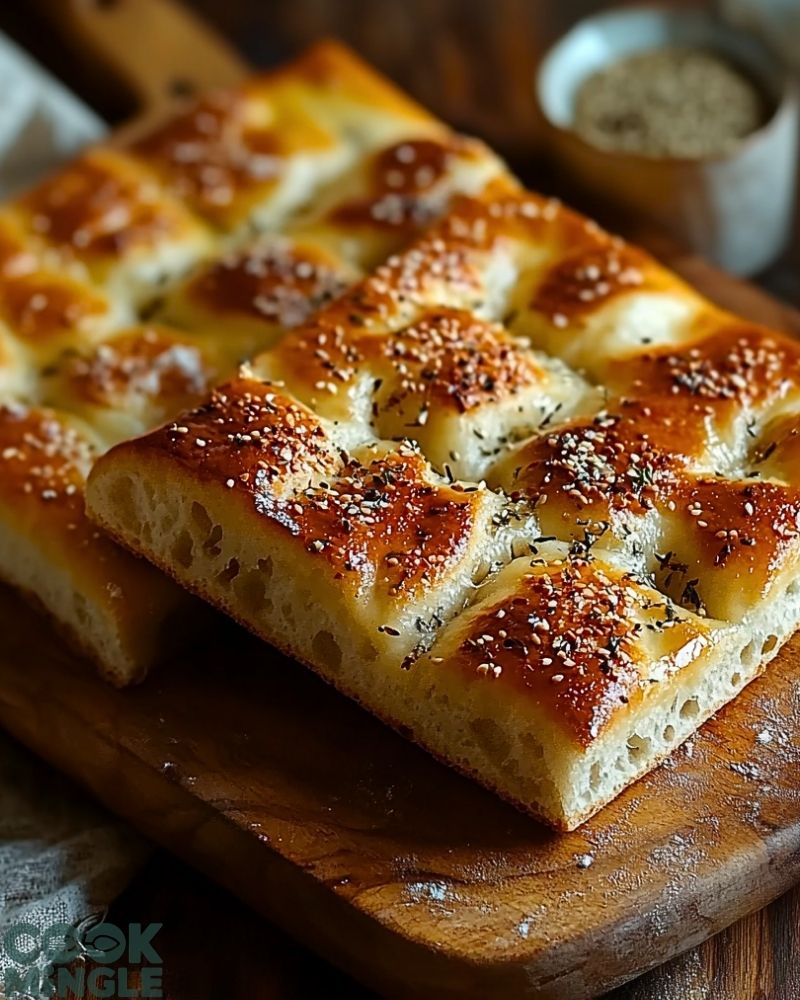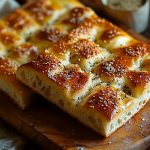Focaccia has always held a special place in my kitchen. There’s something deeply satisfying about pressing your fingers into a soft, airy dough and watching those golden olive oil pools form during baking. The sourdough version? It’s on another level. This Light Fluffy Sourdough Focaccia recipe captures the beauty of simplicity—minimal ingredients, just the right chew, and that unmistakable tang from natural fermentation.

I’ve tried countless focaccia variations, but nothing compares to the lift and lightness of one made with a mature sourdough starter. Whether you’re serving it as a centerpiece, slicing it into sandwiches, or tearing off a piece to dip in olive oil and balsamic, this focaccia never fails to impress. Plus, the crispy bottom and pillowy interior make it an instant favorite for both novice and experienced bakers.
Why You’ll Love This Light Fluffy Sourdough Focaccia
- Unbelievable texture: Thanks to long fermentation, this focaccia is incredibly airy and moist.
- Deep, rich flavor: The natural tang from the sourdough starter brings a depth that commercial yeast can’t match.
- Customizable: Dress it up with herbs, cheeses, garlic, or even sweet toppings like grapes and honey.
- No kneading required: The dough is worked with time, not muscle—perfect for hands-off baking.
- Beautiful crust: The olive oil crisping and gentle dimpling give it that signature bakery-style finish.
What Kind of Flour Should I Use for Light Fluffy Sourdough Focaccia?
To achieve that cloud-like texture with a crisp bottom, the flour you choose plays a big role. I prefer using bread flour because it has a higher protein content, which builds stronger gluten and gives the focaccia that irresistible chew and structure. If you only have all-purpose flour, don’t worry—it’ll still work, but the texture may be a bit softer and less bouncy.
You can even mix in whole wheat flour (no more than 20%) to add a nutty depth. Just keep in mind that whole wheat can weigh down the dough slightly, so allow extra fermentation time if you go that route. For gluten-free versions, you’ll need a specially formulated blend with added binders like xanthan gum to mimic the stretchiness of gluten.
Options for Substitutions
If you’re out of certain ingredients or catering to dietary needs, there are a few workarounds:
- Sourdough Starter: No starter? You can use 1 tsp of active dry yeast and reduce the fermentation time drastically, though you’ll lose the sourdough’s unique flavor.
- Olive Oil: While extra virgin olive oil is traditional and adds wonderful flavor, you can use avocado oil or grapeseed oil in a pinch.
- Toppings: Not a fan of rosemary or flaky salt? Try roasted garlic, caramelized onions, olives, cherry tomatoes, or a blend of Italian herbs.
- Sweet Version: Swap the salt for a drizzle of honey and top with grapes or figs for a sweet twist that pairs beautifully with cheese.
The beauty of focaccia is in how adaptable it is—don’t be afraid to make it your own.
Ingredients for This Light Fluffy Sourdough Focaccia
Each ingredient in this focaccia plays a key role in creating that dreamy texture and bold flavor. Here’s what you’ll need and why it matters:
- Active Sourdough Starter: This is the heart of the recipe, bringing natural fermentation, deep flavor, and that signature rise. Make sure it’s bubbly and ripe before using.
- Bread Flour: Its high protein content supports gluten development, which helps trap air bubbles and creates the chewy, fluffy structure we love in focaccia.
- Water: Hydration is critical—this is a high-hydration dough, which makes it sticky and soft but also helps form those beautiful air pockets during baking.
- Salt: Beyond enhancing flavor, salt also helps tighten the gluten network and strengthens the dough.
- Olive Oil: This adds richness and moisture to the dough while also crisping up the crust. It’s essential for both the dough and for drizzling on top before baking.
- Flaky Sea Salt (for topping): Adds a final savory crunch that contrasts beautifully with the soft interior.
- Optional Toppings (e.g., rosemary, garlic, herbs, sesame, or za’atar): These boost the flavor and bring visual appeal. Use what you love or what’s in season.

Step 1: Feed Your Sourdough Starter
Start by making sure your sourdough starter is active and bubbly. Feed it 4–6 hours before you plan to mix the dough, or the night before if it works better with your schedule. A ripe starter should double in size and pass the “float test” (a small spoonful floats in water).
Step 2: Mix the Dough
In a large mixing bowl, combine your ripe starter, water, and flour. Stir until no dry bits remain. Let this shaggy dough rest (autolyse) for 30–45 minutes. This rest helps hydrate the flour and makes gluten development easier.
Step 3: Add Salt and Olive Oil
After the rest period, add the salt and a drizzle of olive oil. Incorporate them with a few stretch-and-fold motions inside the bowl. This step adds structure and seasoning.
Step 4: Bulk Fermentation with Stretch and Folds
Let the dough rise at room temperature for 4 to 6 hours, depending on the temperature of your kitchen. During the first two hours, perform 3–4 sets of stretch and folds every 30 minutes. To do this, grab one edge of the dough, stretch it upward, then fold it over itself. Rotate the bowl and repeat on all four sides.
Step 5: Cold Proof in the Fridge
Once the dough has bulked up and looks puffy with visible bubbles, transfer it to a well-oiled pan. Gently stretch it toward the corners without deflating. Cover and refrigerate overnight (up to 24 hours). This cold proof enhances flavor and texture.
Step 6: Final Rise and Dimpling
Remove the dough from the fridge and let it come to room temperature for about 2–4 hours. It should puff up again. Drizzle olive oil on top, then use your fingers to gently dimple the dough all over, pressing down without puncturing. This gives focaccia its iconic texture.
Step 7: Add Toppings and Bake
Preheat your oven to 450°F (230°C). Top the dough with flaky salt, herbs, or whatever toppings you love. Bake for 20–25 minutes, until golden brown and crisp at the edges.
Step 8: Cool Slightly Before Serving
Once baked, let the focaccia rest in the pan for 10 minutes. Then transfer it to a wire rack to cool slightly before slicing. This prevents sogginess and keeps the bottom crisp.
How Long to Cook the Light Fluffy Sourdough Focaccia
Baking time is surprisingly quick compared to the hours of fermentation that lead up to it. Once your oven is fully preheated to 450°F (230°C), slide the tray of focaccia in and bake for 20 to 25 minutes.
You’ll know it’s ready when the top turns a deep golden brown and the edges look crisp and slightly caramelized. The bottom should be firm and golden as well—lift a corner gently with a spatula to check. Every oven is a bit different, so start checking around the 20-minute mark.
Tips for Perfect Light Fluffy Sourdough Focaccia
- Use a well-fed starter: This is crucial. If your starter isn’t active, your focaccia won’t rise properly or have that airy crumb.
- Don’t rush fermentation: The long rise is what gives the dough depth of flavor and that cloud-like texture. Plan ahead and be patient.
- Oil generously: Both your pan and the top of the dough should be coated in olive oil. This prevents sticking, encourages a golden crust, and infuses the bread with richness.
- Don’t skip the cold proof: That overnight rest in the fridge is where the magic happens. It helps build structure and flavor.
- Be gentle with the dough: Especially during the final stretch and shaping. Avoid knocking out the air you worked so hard to develop.
- Add toppings just before baking: If added too early, they may sink or affect the rise.
- Use a metal baking pan: It conducts heat better and gives you that crisp, golden base.
- Cool slightly before cutting: Cutting too soon can result in a gummy texture—let it steam off just a bit for the perfect slice.
Watch Out for These Mistakes While Cooking
Even the most forgiving dough can go wrong if a few key missteps are made. Here are the most common mistakes to avoid when making Light Fluffy Sourdough Focaccia:
- Using an inactive starter: If your starter isn’t bubbly and active, your focaccia will be dense. Always test with a float test if unsure.
- Under- or over-fermenting: If the dough hasn’t risen enough, it’ll lack volume. Too much rise and it might collapse or taste overly sour. Trust the look and feel more than the clock.
- Skipping the cold proof: It’s tempting to bake the same day, but the overnight chill is what develops flavor and texture. Skipping this leads to bland bread.
- Not enough oil: Olive oil isn’t just for flavor—it also prevents sticking and helps create a crispy crust. Be generous.
- Rough handling during dimpling: Press with your fingertips gently. If you’re too aggressive, you risk deflating the dough and ruining the air pockets.
- Wrong pan choice: Glass or ceramic pans don’t brown the base like metal does. For best results, go with a well-oiled metal sheet or cake pan.
- Overloading with toppings: Heavy toppings can weigh down the dough and prevent a good rise. Use a light touch or add toppings post-bake.
- Cutting too early: Let it rest for at least 10 minutes after baking. Cutting too soon can make the crumb gummy.
What to Serve With Light Fluffy Sourdough Focaccia?
This focaccia is as versatile as it is delicious. Whether you’re planning a casual lunch or a dinner party, here’s how to make it shine on your table.
Cheese Board Companion
Pair slices of warm focaccia with aged cheeses, soft brie, and fruit for an elevated appetizer.
With Soup
Dunk it into tomato basil soup, creamy pumpkin, or a hearty lentil stew. It soaks up broth beautifully.
Alongside a Fresh Salad
Serve it with a crisp arugula salad tossed in lemon vinaigrette for a light, balanced meal.
Sandwich Bread
Slice it in half horizontally and stuff it with roasted veggies, meats, or mozzarella and pesto.
With Pasta Dishes
Use it to mop up sauces from classics like spaghetti bolognese or creamy Alfredo.
Breakfast Base
Top with scrambled eggs, avocado, and chili flakes for a savory breakfast twist.
Dipped in Olive Oil
Serve it the traditional Italian way—with a side of extra virgin olive oil and balsamic vinegar.
As a Sweet-Savory Snack
Try it with goat cheese and a drizzle of honey or pair with roasted grapes and walnuts.
Storage Instructions
One of the joys of Light Fluffy Sourdough Focaccia is that it stays delicious for days—if stored properly. Here’s how to keep it fresh:
- At Room Temperature (1–2 Days): Wrap the focaccia in parchment paper or foil and store in an airtight container or bread bag. Avoid plastic wrap directly on the crust—it can make it soggy.
- To Reheat: Bring it back to life by placing slices in a 350°F (175°C) oven for 5–10 minutes, or toast it lightly in a skillet with a touch of olive oil.
- In the Freezer (Up to 3 Months): Cut into portions, wrap tightly in foil or plastic wrap, then place in a zip-top freezer bag. Thaw at room temp and reheat in the oven to regain the crusty edges.
- Avoid Refrigeration: It can dry out the bread quickly and dull the flavors.
Estimated Nutrition
While the exact values depend on your toppings and flour choice, here’s a general estimate for a standard piece (about 1/12 of a 9×13-inch pan):
- Calories: ~180
- Fat: 7–9g (mostly from olive oil)
- Carbohydrates: ~25g
- Protein: 4–5g
- Fiber: 1g
- Sugar: <1g
- Sodium: ~200–300mg (depending on salt and toppings)
It’s a hearty, satisfying bread—especially when you consider it’s fermented slowly and full of clean, whole ingredients.
Frequently Asked Questions
What’s the best time to start making sourdough focaccia?
Start in the morning if you plan to do an overnight cold proof, or in the afternoon if you want to shape it before bed. The active prep is minimal, but fermentation time is key—so plan ahead based on your schedule.
Can I use all-purpose flour instead of bread flour?
Yes, all-purpose flour works well, though the focaccia might be slightly less chewy and not as lofty. It will still taste delicious and bake up beautifully.
How do I know when my sourdough starter is ready?
It should be bubbly, doubled in size within 4–6 hours of feeding, and pass the float test (a spoonful floats in water). This means it’s active and ready to leaven your dough.
Can I skip the cold fermentation step?
Technically yes, but I don’t recommend it. The cold proof deepens the flavor and improves the texture significantly. Skipping it often results in a less airy crumb and more muted taste.
What size pan should I use?
A 9×13-inch metal pan is ideal for this recipe. You can also use two 8-inch round pans for smaller loaves or a baking sheet for a thinner crust.
Can I make this gluten-free?
Not with a simple flour swap. You’ll need a gluten-free sourdough starter and a gluten-free flour blend designed for yeast baking, often with xanthan gum for structure.
Why didn’t my dough rise much?
It could be due to an underfed or inactive starter, a cool kitchen temperature, or not giving enough bulk fermentation time. Also, check that your salt isn’t added too early—it can slow down yeast activity if mixed in too soon.
How should I store leftovers?
Wrap in parchment and store in an airtight container at room temperature for up to 2 days, or freeze for longer storage. Reheat in the oven to restore that crusty texture.
Conclusion
This Light Fluffy Sourdough Focaccia is more than just bread—it’s a celebration of patience, flavor, and the joy of baking with your hands. The crisp edges, the light crumb, the olive oil-soaked dimples… every bite tells a story of slow fermentation and thoughtful preparation.
It’s a recipe that welcomes creativity, whether you top it with simple herbs or go bold with roasted vegetables. And thanks to the sourdough base, you’re not just making something delicious—you’re creating something uniquely yours, from starter to slice.

Light Fluffy Sourdough Focaccia
- Total Time: 45 minutes
- Yield: 1 focaccia
Description
Crispy on the outside, airy on the inside—this Light Fluffy Sourdough Focaccia is the kind of bread that elevates every meal. Whether you’re searching for a quick breakfast idea, an easy dinner side, or even a healthy snack option, this focaccia delivers on all fronts. Made with just a few basic ingredients and naturally fermented with your favorite sourdough starter, it’s rich in flavor and soft in texture. The olive oil-crisped crust, combined with the pillowy interior, makes this an irresistible addition to your collection of food ideas and easy recipes. Perfect for beginner bakers or anyone who loves rustic, homemade bread.
Ingredients
- 100g active sourdough starter
- 400g bread flour
- 350g water
- 10g salt
- 30g extra virgin olive oil (plus more for drizzling and greasing)
- Flaky sea salt for topping
- Optional toppings: fresh rosemary, roasted garlic, cherry tomatoes, olives, za’atar
Instructions
- Feed your sourdough starter 4–6 hours before you plan to mix the dough.
- In a large bowl, mix the starter, water, and flour until no dry patches remain. Let it rest for 30–45 minutes.
- Add salt and olive oil. Incorporate with a series of stretch and folds.
- Let the dough ferment at room temperature for 4–6 hours. Perform 3–4 sets of stretch and folds during the first 2 hours.
- Transfer the dough to a well-oiled pan and gently stretch it to the corners. Cover and cold-proof in the fridge overnight.
- The next day, let it come to room temp for 2–4 hours. Dimple the dough with oiled fingers.
- Preheat oven to 450°F (230°C). Add toppings and bake for 20–25 minutes until golden and crisp.
- Cool in the pan for 10 minutes, then transfer to a rack. Serve warm or at room temperature.
- Prep Time: 20 minutes
- Cook Time: 25 minutes

